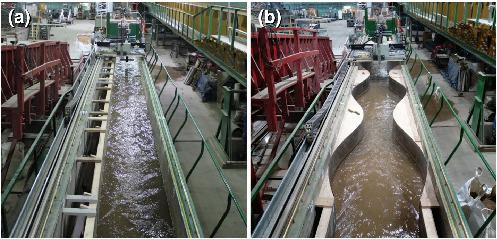当前位置:
X-MOL 学术
›
Earth Surf.Process. Land.
›
论文详情
Our official English website, www.x-mol.net, welcomes your feedback! (Note: you will need to create a separate account there.)
Experimental investigation of the morphodynamic response of riffles and pools to unsteady flow and increased sediment supply
Earth Surface Processes and Landforms ( IF 3.3 ) Pub Date : 2021-01-12 , DOI: 10.1002/esp.5072 Jacob A. Morgan 1, 2 , Peter A. Nelson 1
Earth Surface Processes and Landforms ( IF 3.3 ) Pub Date : 2021-01-12 , DOI: 10.1002/esp.5072 Jacob A. Morgan 1, 2 , Peter A. Nelson 1
Affiliation

|
Gravel‐bed rivers characteristically exhibit shallow riffles in wide sections and deeper pools where the channel becomes constricted and narrow. While rivers can adjust to changing flow and sediment supply through some combination of adjustments of channel slope, bed‐surface sorting, and channel shape, the degree to which riffle‐pools may adopt these changes in response to changing flows and sediment supplies remains unclear. This article presents results from a flume experiment investigating how constant‐ and variable‐width channels adjust their morphology in response to changing flow and increased sediment supply. Two flume geometries were used: (1) constant‐width and (2) variable‐width, characterized by a sinusoidal pattern with a mean width equal to that of the first channel. The variable‐width channel developed bed undulations in phase with the width, representing riffle‐pools. The experiment consisted of three phases for each flume geometry: (1) steady flow, constant sediment supply; (2) unsteady flow, constant sediment supply; and (3) unsteady flow, doubled sediment supply. Unsteady flow was implemented in the form of repeated symmetrical stepped hydrographs, with a mean discharge equal to that in the steady flow phase. In all phases the bed and sediment supply were composed of a sand/gravel mixture ranging from 1 to 8 mm. In both the straight and variable‐width channels, transitioning from steady flow to repeated hydrographs did not result in significant changes in bed morphology. The two channel geometries had different responses to increased sediment supply: the slope of the straight channel increased nearly 40%, while the variable‐width channel reduced the relief between bars and pools and decreased the variability in cross‐sectional elevation with a slight slope increase. Bar‐pool relief varied with repeat discharge hydrographs. Pool elevation changed twice the distance of bar elevations, emphasizing the relevance of pool scour for riffle‐pool self‐maintenance in channels with width variations.
中文翻译:

浅滩和水池对非恒定流和增加泥沙供应的形态动力响应的实验研究
砾石河的特征是在宽阔的区域具有浅浅的浅滩,在河道变得狭窄和狭窄的地方则具有较深的水池。尽管河流可以通过调整河道坡度,河床表面分选和河道形状的组合来适应不断变化的流量和沉积物供应,但不清楚浅滩池对流量和沉积物供应变化的反应采用这些变化的程度。本文介绍了一项水槽实验的结果,该实验研究了恒定宽度和可变宽度的通道如何响应于流量变化和沉积物供应增加而调整其形态。使用了两种水槽几何形状:(1)恒定宽度和(2)可变宽度,其特征是具有平均宽度等于第一个通道的正弦曲线的图案。变宽河道的河床起伏与宽度同相,代表浅滩。实验针对每个水槽的几何形状由三个阶段组成:(1)稳定的流量,恒定的沉积物供应;(2)流量不稳定,泥沙供应量恒定;(3)流量不稳定,泥沙供应量增加了一倍。非恒定流以重复对称的阶梯状水线图的形式实现,其平均流量等于稳定流阶段的平均流量。在所有阶段,床层和沉积物的供给都是由1到8 mm范围内的沙子/砾石混合物组成。在直宽通道和变宽通道中,从稳定流向重复水位图的过渡都不会导致床层形态发生显着变化。这两个通道的几何形状对增加的泥沙供应有不同的响应:直通道的坡度增加了近40%,宽度可变的通道减少了条形和池形之间的起伏,并减小了剖面高程的变化,但坡度略有增加。棒池浮雕随着重复排放水位图的变化而变化。池高程改变了钢筋高程距离的两倍,强调了池冲刷对于宽度变化的通道中浅滩池自维护的相关性。
更新日期:2021-01-12
中文翻译:

浅滩和水池对非恒定流和增加泥沙供应的形态动力响应的实验研究
砾石河的特征是在宽阔的区域具有浅浅的浅滩,在河道变得狭窄和狭窄的地方则具有较深的水池。尽管河流可以通过调整河道坡度,河床表面分选和河道形状的组合来适应不断变化的流量和沉积物供应,但不清楚浅滩池对流量和沉积物供应变化的反应采用这些变化的程度。本文介绍了一项水槽实验的结果,该实验研究了恒定宽度和可变宽度的通道如何响应于流量变化和沉积物供应增加而调整其形态。使用了两种水槽几何形状:(1)恒定宽度和(2)可变宽度,其特征是具有平均宽度等于第一个通道的正弦曲线的图案。变宽河道的河床起伏与宽度同相,代表浅滩。实验针对每个水槽的几何形状由三个阶段组成:(1)稳定的流量,恒定的沉积物供应;(2)流量不稳定,泥沙供应量恒定;(3)流量不稳定,泥沙供应量增加了一倍。非恒定流以重复对称的阶梯状水线图的形式实现,其平均流量等于稳定流阶段的平均流量。在所有阶段,床层和沉积物的供给都是由1到8 mm范围内的沙子/砾石混合物组成。在直宽通道和变宽通道中,从稳定流向重复水位图的过渡都不会导致床层形态发生显着变化。这两个通道的几何形状对增加的泥沙供应有不同的响应:直通道的坡度增加了近40%,宽度可变的通道减少了条形和池形之间的起伏,并减小了剖面高程的变化,但坡度略有增加。棒池浮雕随着重复排放水位图的变化而变化。池高程改变了钢筋高程距离的两倍,强调了池冲刷对于宽度变化的通道中浅滩池自维护的相关性。


























 京公网安备 11010802027423号
京公网安备 11010802027423号